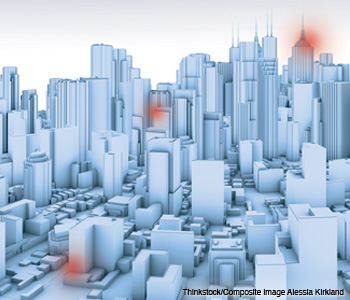 Sensing Trouble: Fiber-Optics in Civil Engineering
Sensing Trouble: Fiber-Optics in Civil EngineeringA wave of new fiber-optic sensing techniques takes advantage of the sensitivity of telecom-grade fiber optics to stress, strain, temperature and other factors in order to ensure the long-term safety of civil structures
Not to alarm you, but the building you’re sitting in may not be safe. The same holds true for the bridge you drove over getting to work and the dam just outside of town. These structures and others are continuously subjected to both common and uncommon stresses and strains that produce flaws. Everything from the weight of people, furniture and machinery to the forces exerted by fires, floods and earthquakes have an effect. Simple cracks and fissures may appear at first due to heavy loads; over time, these will lead to failure.
Manual inspections are par for the course when engineers are trying to determine the safety of buildings and other edifices. However, they are time-consuming and labor-intensive. Moreover, most city, town and state governments are not able to pay for enough inspectors to perform the work on a regular basis. Even if they were, inspections would cover only the easy-to-see exteriors. Most wear and tear, however, starts between walls, or even inside them.
Fortunately, fiber-optic technology provides another alternative. Since standard telecom-grade fiber optics are sensitive to stress, strain, temperature and other deleterious factors, they can be used to monitor buildings, bridges and dams in real-time. The field is known broadly as civil structural health monitoring or simply structural health monitoring (SHM).
Fiber-optic sensor systems react to changes in their environment through minute alterations of their refractive indices as light travels through them. Often, this is achieved by adding fiber Bragg gratings at discrete points along the length of the system. Passing light through a fiber that is attached to a wall, floor or other surface reveals nothing until the surface changes.
However, when a wall shifts—through simple settling or perhaps via a mild temblor—its shape is minutely displaced, resulting in a similarly tiny variation in the light path provided by the fiber. The way in which these changes are measured depends on the anticipated effect, such as stress or temperature. The three optical effects most often analyzed in fiber sensors are Rayleigh, Raman and Brillouin scattering.
Depending on the design of the fiber and the method of reading the output spectra, an engineer can determine the total forces acting on a structure and thus judge whether it is in need of repair.
When the input light is provided by a pulsed laser, the location of the spot on the fiber that experienced the change can be determined with relatively good spatial resolution—usually depending on the distance between the stress point and the scanner reading the output.